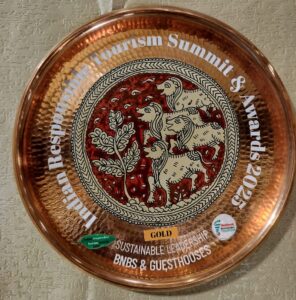At the heart of Maiyam lies a profound philosophy that transcends mere culinary delights – it embodies balance and harmony, particularly in the realms of nutrition and taste. The word
“Maiyam,” which means “centre” in Tamizh, symbolizes a core belief in drawing on traditional wisdom while integrating scientific learning. This philosophy is centred around promoting wholesome, cultural, and sustainable food practices.
Vijhay Ganesh, the visionary chef behind Maiyam, is constantly seeking new ways to share his passion for food, tradition, and sustainability. Recently, he found a perfect setting for his next culinary adventure: Vaksana Farms.
Vaksana Farms, known for its commitment to organic and sustainable farming practices, provided the ideal backdrop for Vijhay’s workshop. Inspired by the farm’s ethos and the abundance of natural ingredients available, Vijhay decided to create a workshop that would not only educate but also inspire participants to reconnect with food in a meaningful way.
The workshop at Vaksana Farms was designed to be a sensory journey, guiding participants towards ingredients that truly nourish and satisfy. Vijhay wanted to show that everyone is equipped to identify the difference between authentic and adulterated products, simply by using their senses. He believed that when our tools are our eyes, nose, tongue, and even ears, we do not need certificates or brand images to believe in quality.
Moreover, Vijhay wanted to highlight the importance of supporting passionate individuals who focus on quality rather than profit-oriented brands. He emphasized that good quality ingredients can only be produced in small batches, with a low carbon footprint, and in simpler processes. Through the workshop, he aimed to empower participants to demand quality and shape the future of the food system.
By hosting the workshop at Vaksana Farms, Vijhay is hoping to create an immersive experience that would not only educate participants but also inspire them to reevaluate their relationship with food. He believed that by re-calibrating their senses and identifying ingredients that create a healthy sense of cravings, participants could break away from conditioned food habits and rediscover flavours that have been underappreciated.
In conclusion, Vijhay’s workshop at Vaksana Farms was more than just a culinary event; it was a transformative experience that encouraged participants to think differently about the food they consume. Through his innovative approach and commitment to sustainability, Vijhay continues to inspire others to embrace a more conscious way of living and eating.
Vijhay Ganesh, the founder and chef of Maiyam, is not just a culinary artist; he is a visionary who has dedicated his life to redefining the boundaries of taste, tradition, and sustainability. Vijhay’s journey as a chef began with a deep-rooted passion for exploring the culinary landscape of South India. Through years of travel and exploration, he has honed his skills, drawing inspiration from family recipes, traditional healers, food researchers, and professional chefs.
One of the key pillars of Vijhay’s culinary philosophy is the concept of sensory exploration. He believes that the conventional products we consume often fail to stimulate our senses to their full potential. This realization has led him to seek out ingredients that offer a sensory experience that extends far beyond these limitations. Through Maiyam, Vijhay crafts food-based experiences that not only satisfy the palate but also bring a sense of fulfilment and satiation to his patrons.
Central to Vijhay’s approach is his emphasis on quality ingredients. In a world where commercialization often compromises quality, Vijhay stands firm in his belief that good quality ingredients can only come from small batches, with a low carbon footprint, and in simpler processes. He encourages participants to develop the skills to identify and demand quality from passionate individuals who focus on quality rather than profit-oriented brands.
Through workshops and dinners curated by Vijhay, participants are invited to re-calibrate their senses, enabling them to identify ingredients that truly nourish and satisfy. These experiences are designed to break away from conditioned food habits and rediscover Flavors that have been underappreciated. Vijhay’s culinary creations not only tantalize the taste buds but also serve as a reminder of the rich cultural heritage and sustainable food practices that form the backbone of our culinary traditions.
Vijhay Ganesh and Maiyam represent more than just a culinary venture; they are a celebration of taste, tradition, and sustainability. Through his innovative approach to food and culinary experiences, Vijhay invites us to embark on a journey of rediscovery – of Flavors, of ingredients, and ultimately, of ourselves.
Milk Quality:
A grass-fed cow’s milk has an inviting smell and a hint of earthy aroma.
Clean milk will turn sour faster if not boiled within a few hours of milking.
After boiling, milk remains consumable for about 12 hours without refrigeration or re-boiling.
Curd Making Process:
Boil milk for about 20 minutes on low heat to get thick and creamy curd.
Add the starter curd when the milk is warmer than room temperature for better fermentation.
The quantity of starter used affects the fermentation process; more starter leads to a shorter fermentation time.
Starters need to be completely broken down into a creamy consistency before adding to the milk.
Curd Storage and Vessels:
Use river clay pots or soap stones for making curd, as bacteria thrive in earthy vessels.
A glass container is not recommended, as light is unfavourable for bacterial proliferation.
Cover the container with a lid and do not disturb it until the curd is ready.
Nutritional Value:
Full-fat cream curd is considered real curd and is beneficial for the brain.
Curd from skimmed milk may not have the same brain-essential nutrients as full-fat cultured cream.
Jaggery
The prime difference between good and adulterated jaggery is that okra juice is used to clean the debris rather than acids, calcium pastes or chemicals respectively.
Liquid jaggery is the first step of the product derived from removing the moisture from the cane juice
Block jaggery is the second sellable product, it is made by letting the jaggery sit in a mould and allowed to cool down slowly.
Country sugar is the last step where the block jaggery is rapidly cooled by scattering it instead of calling it in a mould.
Extraction Methods:
Heatless extraction of oil from oil seeds is considered the best method for consumption because heat can destroy beneficial molecules.
Commercial processes often use high temperatures or chemicals to extract oil, as they provide higher yields compared to heat-free methods.
Oils extracted using high-temperature methods or chemicals tend to have a bland smell.
Quality Indicators:
True cold-pressed oils have a distinct smell that can evoke a euphoric feeling, which is often considered a good indicator of their quality.
Cold-pressed oils should not be smoked, as this can make them carcinogenic.
Best Practices:
Extracting oil from sun-dried nut seeds in a wood press mill is considered the best quality method.
This process helps retain the natural flavours and nutrients of the seeds, producing high-quality, flavourful oils.
These points highlight the importance of extraction methods in preserving the quality and nutritional value of plant-based fats. Choosing oils extracted using heatless methods can help ensure that you’re getting the best possible product.
Coconut Oil:
Coconut oil is best used raw, but it can also be used for deep frying due to its stability at high temperatures.
When deep frying with coconut oil, it’s important to ensure that the oil is not smoking, as this can indicate that it has reached its smoke point.
Coconut oil is a defining ingredient in Kerala cuisine, where it is used in a variety of dishes.
Sesame Oil:
Sesame oil is best used raw or for tempering with spices, as it has a low smoking point and can become bitter when overheated.
Chinese and Japanese sesame oil is toasted before extracting oil, while in India, sesame seeds are sun-dried instead.
In Dravidian cuisine, sesame oil is often extracted along with palm jaggery to balance the heat from the sesame.
Peanut Oil:
Peanut oil is one of the most versatile oils in the cold-pressed category, making it suitable for a variety of culinary uses.
It has a high smoking point among cold-pressed oils, making it ideal for deep frying.
Peanuts were introduced to Indian cuisine around the early 20th century and became popular during the Second World War when the oil extracted was sent to British forces as a source of fats.
Safflower Oil:
Safflower oil can be treated similarly to peanut oil, as it also has a high smoking point.
It is one of the oldest oils used in India and is a defining ingredient in Central Indian cuisine, including North Karnataka cuisine.
These points highlight the versatility and culinary importance of different plant-based fats in Indian cuisine, showcasing their unique Flavors and cooking properties.
Dairy Fats:
The quality of dairy fats, such as ghee, is determined by the quality of the milk from which they are derived.
Butter consumption in India became more prevalent with the advent of refrigeration, as butter spoils quickly in warm climates. Ghee, which is butter with the moisture removed, became a more popular and stable alternative.
Originally, ghee was made from the cream of curd, but most commercially available ghee today is made from the cream of milk due to industrial processes.
Butter made from curd cream contains probiotic elements and has a slightly sour taste compared to cream ghee.
Cultured butter turned into ghee contains more beneficial molecules, giving it a more complex taste.
Ghee is best used melted on hot foods as a garnish and should not be heated or smoked.
Once heated, ghee should be consumed before cooling, as its nature changes when the temperature fluctuates.
Palm stearin, a waste product full of saturated fats, is processed and made into dalda/vanaspati, which is used for adulterating commercial ghee.
Ghee is excellent for tempering lentil soups, rasam, and other dishes, serving as an accompaniment for rice.
Cream Ghee:
Cream ghee is a less expensive alternative to cultured ghee and is suitable for recipes that require smoking the ghee.
It is best used for tempering spices regularly and is harder to detect adulteration compared to cultured ghee due to its neutral smell.
Curd Ghee:
Curd ghee is considered one of the best-quality fats for human consumption.
It can be identified by its distinctive smell, which can have a positive effect on our moods.
Curd ghee has a lower melting point compared to cream ghee and should be used only as a garnish or for low-heat tempering, as its nutritional value depletes when heated.
It is best used in dishes like biryani and sweet dishes.
These details provide a deeper understanding of the qualities and uses of different types of ghee, highlighting their significance in Indian cuisine and the importance of choosing high-quality dairy fats for cooking and garnishing.








